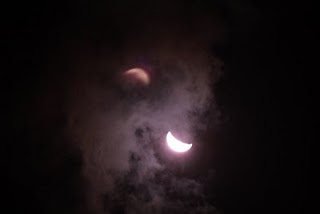This astonishing photo of the Milky Way over Binbrook, Ontario, Canada, was taken by Kerry-Ann Lecky Hepburn of Weather and Sky Photography:
We are really lucky watch picture of it that the water was beautiful and still enough so that the stars castled a nice reflection in the water. In this shot you can also see Jupiter, various nebulas in the MilkyWay, Rho Ophiuchus and the light dome from a distant town.
Monday, April 26, 2010
Monday, April 19, 2010
Thursday, April 15, 2010
Hiding at the back of Milky Way
Stargazers and specialized astronomers have a tough time watching the galaxy through the Milky Way's bright band of stars, dust and gas. WISE's infrared vision cuts all the way through this veil, offering a brittle view.
In a spiral galaxy like IC 342, dust and gas are concerted in the arms. The denser pockets of gas activate the formation of new stars, as represented here in green and yellow. The center, shown in red, is also bursting with young and youthful stars, which are heating up dust. Stars that come out blue be located within our Milky Way, between us and IC 342.
This galaxy has been of great attention to astronomers since it is comparatively close. However, determining its distance from Earth has confirmed complication due to the intervening Milky Way. Astronomer Edwin Hubble first thought the galaxy might fit in to our own Local Group of galaxies, however present estimates now place it farther away, at about 6.6 to 11 million light-years.
This picture was made from observations by all four infrared detectors on board WISE. Blue and cyan stand for infrared light at wavelengths of 3.4 and 4.6 microns, which is principally light from stars. Green and red symbolize light at 12 and 22 microns, which is primarily emission from warm dust.
Friday, April 09, 2010
2 moons Phases -Believe it or not
Two moons, believe it or not. The moon has been crevice asunder two or two moons in the sky? This image is recorded on 19 February 2010 at 21:00 hours on the beach Mek Mas Kelantan, Malaysia. This image is recorded with the Canon 50D + telephoto lens.
The phase of the moon: 34.9%
Altitude: 33d 11m
Phase angle: 107.54d
Rise: 11:28
Set: 23:58
Wednesday, April 07, 2010
The Big Bang Process
The majority astronomers consider the Universe began in a Big Bang about 14 billion years ago. At that point, the complete Universe was within a bubble that was thousands of times lesser than a pinhead. It was hotter and denser than whatever thing we can envisage.
Then it abruptly exploded. The Universe that we are familiar with was born. All the three Time, space and matter began with the Big Bang. In a fraction of a second, the Universe grew from smaller than a solitary atom to bigger than a galaxy. And it kept on rising at a fantastic rate. It is still growing today.
As the Universe prolonged and cooled, energy distorted into particles of matter and antimatter. These two conflicting types of particles mainly smashed each other. But some matter survived. More steady particles called protons and neutrons on track to form when the Universe was one second old.
Over the next three minutes, the temperature dropped underneath 1 billion degrees Celsius. It was currently cool enough for the protons and neutrons to approach together, forming hydrogen and helium nuclei.
Thursday, April 01, 2010
Cosmic Dust present Milky Way a flaming Mane
The Planck space telescope, which is surveying the complete sky in four huge sweeps, has almost completed its first scan.
Revolving in orbit, Planck obtains data of the sky in strips, approximately the reverse of a chef flaking an apple in one long, thin strip.
This image, taken as of the scan, gives you an idea about the structure and form of dust clouds inside about 500 light-years of the sun. The brilliant band in this far-infrared image is the Milky Way’s spiral disk. On top of that, you can see the cold dust arching upwards. The tint palette here is a bit strange: Reddish tones are colder, whereas white tones are warmer.
The Planck task, initiated on May 2009 by the European Space Agency, is creating the best-ever map of the cosmic environment radiation left over from the Big Bang 13.7 billion years ago.
Subscribe to:
Comments (Atom)








